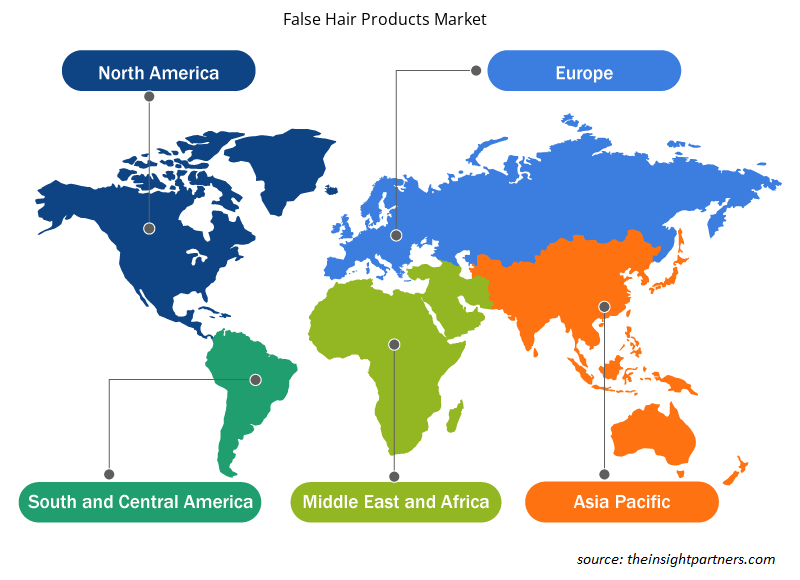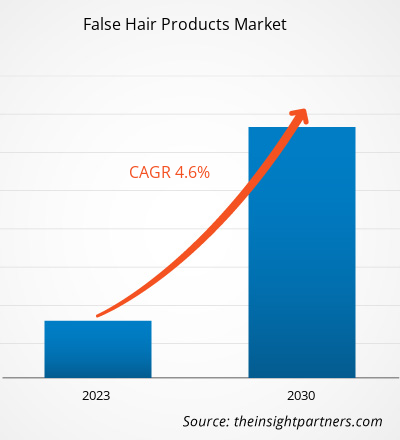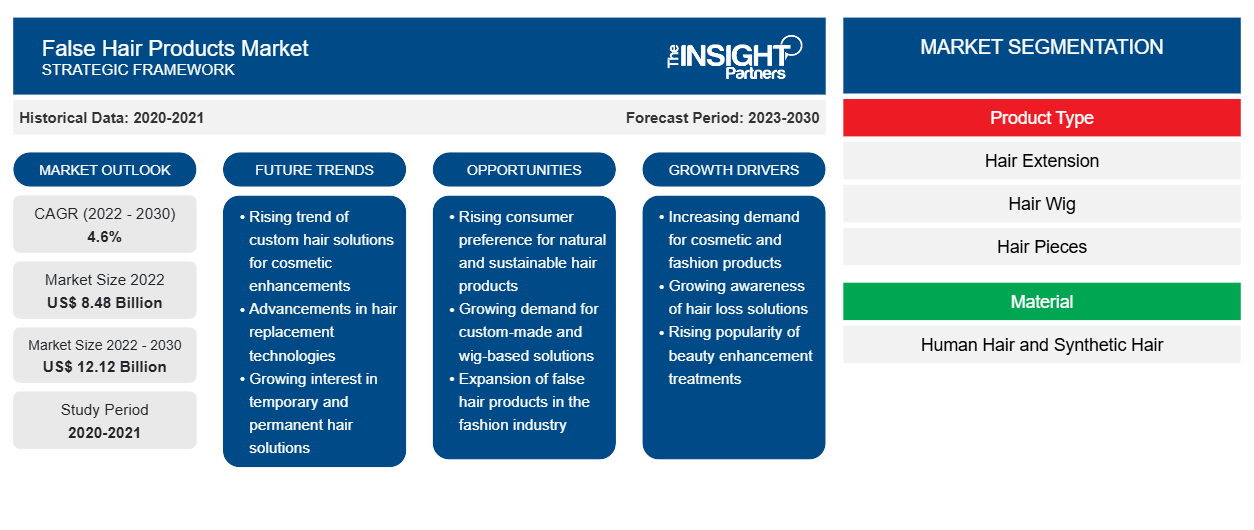[Forschungsbericht] Der Markt für Kunsthaarprodukte hatte im Jahr 2022 einen Wert von 8.484,19 Millionen US-Dollar und soll bis 2030 12.115,21 Millionen US-Dollar erreichen; von 2022 bis 2030 wird eine durchschnittliche jährliche Wachstumsrate (CAGR) von 4,6 % erwartet.
Markteinblicke und Analystenansichten:
Kunsthaarprodukte sind künstliche Haarteile, die das natürliche Aussehen des Haares verbessern oder verändern sollen. Diese Produkte sind in verschiedenen Formen erhältlich, darunter Haarverlängerungen, Haarperücken und Haarteile. Sie werden häufig verwendet, um dem Haar Länge, Volumen oder verschiedene Farben zu verleihen. Kunsthaarprodukte können aus synthetischen Fasern oder natürlichem Menschenhaar hergestellt werden und bieten den Menschen die Flexibilität, mit verschiedenen Frisuren zu experimentieren, ohne sich auf dauerhafte Veränderungen einlassen zu müssen. Obwohl diese Produkte sofortige Veränderungen bewirken können, ist es wichtig, hochwertige Optionen auszuwählen und sie richtig zu verwenden, um ein natürliches und nahtloses Aussehen zu erzielen.
Wachstumstreiber und Herausforderungen:
Chemotherapie, Strahlentherapie und andere medizinische Behandlungen gegen Krebs zielen darauf ab, sich schnell teilende Zellen zu eliminieren, zu denen leider auch Haarfollikel gehören. Infolgedessen erleiden Patienten, die sich einer Krebsbehandlung unterziehen, häufig erheblichen Haarausfall, der emotional belastend sein und ihr Selbstwertgefühl beeinträchtigen kann.
Nach Schätzungen der Internationalen Agentur für Krebsforschung (IARC) wurden 2018 weltweit 17,0 Millionen neue Krebsfälle und 9,5 Millionen Krebstodesfälle gemeldet. Bis 2040 dürften die Zahl der neuen Krebsfälle und Todesfälle aufgrund veränderter Lebens- und Ernährungsgewohnheiten sowie des Alkohol- und Rauchkonsums auf 27,5 Millionen bzw. 16,3 Millionen steigen. Aufgrund der zunehmenden ungesunden Ernährung, des steigenden Rauchverhaltens und der Bewegungsmangels dürfte die Belastung in Ländern im wirtschaftlichen Wandel künftig noch größer sein.
Die Nachfrage nach Kunsthaarprodukten ist aufgrund des weit verbreiteten Haarausfalls durch Krebsbehandlungen deutlich gestiegen. Kunsthaarprodukte wie Perücken, Extensions usw. bieten eine wirksame Lösung für Patienten, die ihr Aussehen bewahren und im Kampf gegen den Krebs ein gewisses Gefühl von Normalität zurückgewinnen möchten. Um den Bedürfnissen von Krebspatienten gerecht zu werden, bieten Marktteilnehmer für Kunsthaarprodukte eine breite Produktpalette an, darunter Perücken aus Naturhaar, Kunsthaarperücken, Kunsthaarteile, Naturhaarteile und personalisierte Designs. Hersteller von Kunsthaarprodukten haben die Qualität und den Tragekomfort ihrer Produkte verbessert und stellen sicher, dass Krebspatienten Zugang zu bequemen und realistisch aussehenden Kunsthaarprodukten haben, die ihnen helfen, ihr Selbstvertrauen in einer schwierigen Zeit zu stärken.
Das Wachstum des Marktes für Kunsthaarprodukte wird auch durch das zunehmende Bewusstsein und Verständnis für Krebs und seine Auswirkungen auf Patienten vorangetrieben. Hilfsorganisationen, medizinische Zentren und Gemeinschaftsinitiativen haben die Verfügbarkeit und Vorteile von Perücken und Extensions für Krebspatienten aktiv gefördert und sie ermutigt, Kunsthaarprodukte als eine stärkende Option zu nutzen. Die Cherian Foundation (TCF), eine private Wohltätigkeitsstiftung mit Sitz in Chennai, Indien, startete eine Kampagne namens „Gift Hair Gift Confidence“. Im Rahmen dieser Kampagne schloss sich die Stiftung mit Dabur Amla Hair Oil zusammen, um am Weltkrebstag 2022 eine Haar- und Perückenspendeaktion durchzuführen. Ziel der Kampagne war es, das Stigma rund um Krebs auszumerzen und eine frühzeitige Krebserkennung bei Frauen zu fördern. Ziel dieser Kampagne ist es, 150 Perücken kostenlos an unterprivilegierte Krebspatienten zu verteilen, damit diese dem Leben mit neuem Selbstvertrauen begegnen können. Daher treiben die zunehmenden Fälle von Haarausfall aufgrund von Krebsbehandlungen das Wachstum des Marktes für Kunsthaarprodukte voran.
Unethische Praktiken in der Haarindustrie haben zu verbotenen Aktivitäten wie dem illegalen Verkauf von Haaren und der geringeren Entlohnung der in der Haarindustrie tätigen Arbeiter geführt. Der Verkauf von Haaren erfolgt hauptsächlich über kleine Agenten und Vermittler, die Dörfer in Ländern wie China, Indien und Osteuropa bereisen und verarmten Frauen kleine Zahlungen anbieten, damit sie sich von ihren Haaren trennen. Jüngsten Untersuchungen zufolge verkaufen Personen, die in einkommensschwachen Regionen finanzielle Schwierigkeiten haben, ihre Haare. In Indien gibt es verschiedene unethische Praktiken im Zusammenhang mit dem Verkauf von Haaren. So werden beispielsweise Slumkinder dazu verleitet, sich im Tausch gegen Spielzeug den Kopf zu rasieren; manchmal zwingen Ehemänner ihre Frauen, ihre Haare zu verkaufen. Darüber hinaus sind sogar Schmuggler am illegalen Handel mit rohem Menschenhaar indischen Ursprungs nach China über Landwege beteiligt. Durch den Schmuggel über das Land werden über 28 % der Einfuhrzölle eingespart, während den Kindern, die Haarsträhnen in rohem und unbearbeitetem Menschenhaar trennen und isolieren, nur ein Hungerlohn gezahlt wird. Alle oben genannten Faktoren wirken sich also negativ auf den globalen Markt für Kunsthaarprodukte aus.
Passen Sie diesen Bericht Ihren Anforderungen an
Sie erhalten kostenlos individuelle Anpassungen an jedem Bericht, einschließlich Teilen dieses Berichts oder einer Analyse auf Länderebene, eines Excel-Datenpakets sowie tolle Angebote und Rabatte für Start-ups und Universitäten.
- Holen Sie sich die wichtigsten Markttrends aus diesem Bericht.Dieses KOSTENLOSE Beispiel umfasst eine Datenanalyse von Markttrends bis hin zu Schätzungen und Prognosen.
Berichtssegmentierung und -umfang:
Der globale Markt für Kunsthaarprodukte ist nach Produkttyp, Material, Endverbraucher, Vertriebskanal und Geografie segmentiert. Der Markt für Kunsthaarprodukte ist nach Produkttyp in Haarverlängerungen , Haarperücken und Haarteile unterteilt. Nach Material ist der Markt für Kunsthaarprodukte in Echthaar und Kunsthaar unterteilt. Nach Endverbraucher ist der Markt in Männer, Frauen und Kinder segmentiert. Nach Vertriebskanal ist der Markt in Supermärkte und Hypermärkte, Fachgeschäfte, Online-Einzelhandel und andere segmentiert. Nach Geografie ist der globale Markt für Kunsthaarprodukte grob in Nordamerika, Europa, Asien-Pazifik, den Nahen Osten und Afrika sowie Süd- und Mittelamerika segmentiert.
Segmentanalyse:
Basierend auf dem Produkttyp ist der Markt für Kunsthaarprodukte in Haarverlängerungen, Haarperücken und Haarteile unterteilt. Das Segment Haarverlängerungen wird im Prognosezeitraum voraussichtlich die höchste durchschnittliche jährliche Wachstumsrate verzeichnen. Haarverlängerungen sind zu einer revolutionären Lösung in der Schönheits- und Modewelt geworden. Mit der Fähigkeit, natürlichem Haar sofort Länge, Volumen und sogar Highlights zu verleihen, bieten sie eine vielseitige Möglichkeit, eine Vielzahl von Looks zu erzielen. Der Markt für das Segment Haarverlängerungen erlebt aufgrund der steigenden Nachfrage nach schnellen und vorübergehenden Frisurenänderungen ein schnelles Wachstum. Social-Media-Plattformen, Beauty-Influencer und Prominente präsentieren regelmäßig verschiedene Frisuren und inspirieren Menschen, mit ihrem Aussehen zu experimentieren. Darüber hinaus sind Haarverlängerungen für Menschen mit kürzerem Haar und für Menschen mit feinem oder dünnem Haar geeignet, die sich mehr Volumen wünschen. Da sich die Qualität und Vielfalt der Verlängerungen weiter verbessert und die Menschen die Idee, Verlängerungen als Mittel zum kreativen Ausdruck zu verwenden, annehmen, wird der Markt für Kunsthaarprodukte im Segment Haarverlängerungen in den kommenden Jahren voraussichtlich wachsen.
Regionale Analyse:
Der Markt für Kunsthaarprodukte ist in fünf Schlüsselregionen unterteilt: Nordamerika, Europa, Asien-Pazifik, Süd- und Mittelamerika sowie den Nahen Osten und Afrika. Nordamerika dominierte den globalen Markt für Kunsthaarprodukte, und der regionale Markt machte im Jahr 2022 2.995,52 Millionen US-Dollar aus. Europa ist ein zweitgrößter Marktteilnehmer mit einem Anteil von über 29 % am Weltmarkt. Der Asien-Pazifik-Raum wird im Prognosezeitraum voraussichtlich eine beträchtliche CAGR von über 5 % verzeichnen. Der Markt für Kunsthaarprodukte im Asien-Pazifik-Raum ist in China, Indien, Japan, Südkorea und Australien unterteilt. Eine zunehmende Zahl von Menschen in Indien, China und Japan, die aufgrund von Stress, Autoimmunerkrankungen (Alopezie), Umweltverschmutzung, Pilzinfektionen, Krebs, hormonellem Ungleichgewicht und polyzystischem Ovarialsyndrom (POS) unter Haarausfall leiden, treibt die Nachfrage nach Kunsthaarprodukten als Lösung zur Verbesserung des Aussehens an. Fortschritte bei den Herstellungstechniken und -materialien für Perücken und Extensions haben zu qualitativ hochwertigeren, realistisch aussehenden Perücken geführt, die Verbraucher dazu bewegen, sich für sie zu entscheiden. Evergreen Products Group Ltd, Henan Ruimei Products Co Ltd, Artnature Co Ltd und Lordhair Co Ltd gehören zu den wichtigsten Herstellern, die den Markt für Kunsthaarprodukte im asiatisch-pazifischen Raum dominieren. Darüber hinaus sind diese führenden Hersteller in der Region bestrebt, ihre Präsenz auf dem Markt kontinuierlich auszubauen.
Regionale Einblicke in den Markt für Kunsthaarprodukte
Die regionalen Trends und Faktoren, die den Markt für Kunsthaarprodukte während des Prognosezeitraums beeinflussen, wurden von den Analysten von Insight Partners ausführlich erläutert. In diesem Abschnitt werden auch Marktsegmente und Geografie für Kunsthaarprodukte in Nordamerika, Europa, im asiatisch-pazifischen Raum, im Nahen Osten und Afrika sowie in Süd- und Mittelamerika erörtert.

- Erhalten Sie regionale Daten zum Markt für Kunsthaarprodukte
Umfang des Marktberichts über Kunsthaarprodukte
| Berichtsattribut | Details |
|---|---|
| Marktgröße im Jahr 2022 | 8,48 Milliarden US-Dollar |
| Marktgröße bis 2030 | 12,12 Milliarden US-Dollar |
| Globale CAGR (2022 - 2030) | 4,6 % |
| Historische Daten | 2020-2021 |
| Prognosezeitraum | 2023–2030 |
| Abgedeckte Segmente | Nach Produkttyp
|
| Abgedeckte Regionen und Länder | Nordamerika
|
| Marktführer und wichtige Unternehmensprofile |
|
Dichte der Marktteilnehmer für Kunsthaarprodukte: Die Auswirkungen auf die Geschäftsdynamik verstehen
Der Markt für künstliche Haarprodukte wächst rasant. Dies wird durch die steigende Nachfrage der Endverbraucher aufgrund von Faktoren wie sich entwickelnden Verbraucherpräferenzen, technologischen Fortschritten und einem größeren Bewusstsein für die Vorteile des Produkts vorangetrieben. Mit der steigenden Nachfrage erweitern Unternehmen ihr Angebot, entwickeln Innovationen, um die Bedürfnisse der Verbraucher zu erfüllen, und nutzen neue Trends, was das Marktwachstum weiter ankurbelt.
Die Marktteilnehmerdichte bezieht sich auf die Verteilung von Firmen oder Unternehmen, die in einem bestimmten Markt oder einer bestimmten Branche tätig sind. Sie gibt an, wie viele Wettbewerber (Marktteilnehmer) in einem bestimmten Marktraum im Verhältnis zu seiner Größe oder seinem gesamten Marktwert präsent sind.
Die wichtigsten auf dem Markt für Kunsthaarprodukte tätigen Unternehmen sind:
- Evergreen Products Group GmbH
- Hairuwear Inc
- Henan Ruimei Produkte Co Ltd
- Artnature Co Ltd
- Shake-N-Go Inc
Haftungsausschluss : Die oben aufgeführten Unternehmen sind nicht in einer bestimmten Reihenfolge aufgeführt.

- Überblick über die wichtigsten Akteure auf dem Markt für Kunsthaarprodukte
Auswirkungen der COVID-19-Pandemie:
Die COVID-19-Pandemie behinderte den globalen Markt für Kunsthaarprodukte zunächst aufgrund der Schließung von Produktionsstätten, Arbeitskräftemangel, Unterbrechung der Lieferketten und finanzieller Instabilität. Die Unterbrechung verschiedener Branchen aufgrund der durch den COVID-19-Ausbruch verursachten wirtschaftlichen Abschwächung schränkte das Angebot an Kunsthaarprodukten ein. Verschiedene Geschäfte für Kunsthaarprodukte wurden geschlossen. Die Unternehmen gewinnen jedoch an Boden, da zuvor verhängte Beschränkungen in verschiedenen Ländern gelockert wurden. Darüber hinaus entspannte die Einführung von COVID-19-Impfstoffen durch Regierungen verschiedener Länder die Situation und führte zu einem Anstieg der Geschäftsaktivitäten weltweit. Mehrere Märkte, darunter der Markt für Kunsthaarprodukte, verzeichneten nach der Lockerung von Lockdowns und Bewegungseinschränkungen Wachstum.
Wettbewerbslandschaft und Schlüsselunternehmen:
Zu den führenden Akteuren auf dem weltweiten Markt für Kunsthaarprodukte zählen Evergreen Products Group Ltd, Hairuwear Inc, Henan Ruimei Products Co Ltd, Artnature Co Ltd, Shake-N-Go Inc, Papillon Hair World, Locks & Bonds, Klix Hair Inc, Easihair Pro und Balmain Hair Group BV.
- Historische Analyse (2 Jahre), Basisjahr, Prognose (7 Jahre) mit CAGR
- PEST- und SWOT-Analyse
- Marktgröße Wert/Volumen – Global, Regional, Land
- Branchen- und Wettbewerbslandschaft
- Excel-Datensatz
Aktuelle Berichte
Verwandte Berichte
Erfahrungsberichte
Grund zum Kauf
- Fundierte Entscheidungsfindung
- Marktdynamik verstehen
- Wettbewerbsanalyse
- Kundeneinblicke
- Marktprognosen
- Risikominimierung
- Strategische Planung
- Investitionsbegründung
- Identifizierung neuer Märkte
- Verbesserung von Marketingstrategien
- Steigerung der Betriebseffizienz
- Anpassung an regulatorische Trends























 Kostenlose Probe anfordern für - Markt für künstliche Haarprodukte
Kostenlose Probe anfordern für - Markt für künstliche Haarprodukte